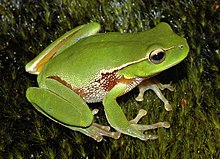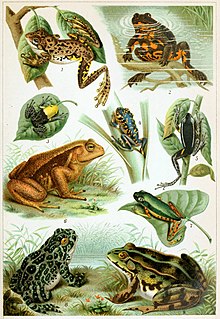Portal:Amphibians
The Amphibian Portal
Amphibians are ectothermic, anamniotic, four-limbed vertebrate animals that constitute the class Amphibia. In its broadest sense, it is a paraphyletic group encompassing all tetrapods, excluding the amniotes (tetrapods with an amniotic membrane, such as modern reptiles, birds, and mammals). All extant (living) amphibians belong to the monophyletic subclass Lissamphibia, with three living orders: Anura (frogs), Urodela (salamanders), and Gymnophiona (caecilians). Evolved to be mostly semiaquatic, amphibians have adapted to inhabit a wide variety of habitats, with most species living in freshwater, wetland or terrestrial ecosystems (such as riparian woodland, fossorial and even arboreal habitats). Their life cycle typically starts out as aquatic larvae with gills known as tadpoles, but some species have developed behavioural adaptations to bypass this.
The young generally undergo metamorphosis from larva with gills to an adult air-breathing form with lungs. Amphibians use their skin as a secondary respiratory surface and some small terrestrial salamanders and frogs lack lungs and rely entirely on their skin. They are superficially similar to reptiles like lizards, but unlike reptiles and other amniotes, require water bodies in which to breed. With their complex reproductive needs and permeable skins, amphibians are often ecological indicators; in recent decades there has been a dramatic decline in amphibian populations for many species around the globe.
The earliest amphibians evolved in the Devonian period from sarcopterygian fish with lungs and bony-limbed fins, features that were helpful in adapting to dry land. They diversified and became ecologically dominant during the Carboniferous and Permian periods, but were later displaced in terrestrial environments by early reptiles and basal synapsids (mammal predecessors). The origin of modern amphibians belonging to Lissamphibia, which first appeared during the Early Triassic, around 250 million years ago, has long been contentious. However the emerging consensus is that they likely originated from temnospondyls, the most diverse group of prehistoric amphibians, during the Permian period. (Full article...)
Selected frog article
Brevicipitidae or rain frogs is a small family of frogs found in eastern and southern Africa. As of 2020 contains 37 species in 5 genera. Formerly included as subfamily in Microhylidae (narrow-mouth frogs), phylogenetic research has indicated the brevicipitine frogs should be considered as a family with Hemisotidae (shovelnose frogs) as the most closely related sister taxon.
Most adult brevicipitine frogs are not easily seen as they spend extended periods of time in soil or leaf litter. However, some species might be partly arboreal at times. Many species show strong sexual size dimorphism, with females being much larger than males.
At least the frogs in Breviceps and Probreviceps genera breed by direct development, in which small froglets emerge from eggs without intervening aquatic tadpole phase. It is likely that the same applies to the other genera, too. Because male Breviceps frogs are smaller than their female counterparts, amplexus is not possible; however mating pairs glue themselves together using excretions from holocrine glands on the ventrum of the male and similar glands on the dorsum of the back of the female. The frogs lay small clutches of 13–56 fairly large eggs (4–8 mm diameter not including the protective capsule) in cover, often in burrows. With some species either male or female stays with eggs or close to the egg chamber, though the details and extent of brood care is poorly understood within Brevicipitidae as a whole. (Full article...)Selected salamander article
List of selected salamander articles
|
|---|
Did you know? –

- ... that Lehmann's poison frog is not toxic in captivity because its poison derives from food it eats only in the wild?
- ... that the Brazil-nut poison frog (pictured) sometimes places its tadpoles in water-filled capsules that have fallen from the Brazil nut tree?
- ... that female gregarious slender salamanders often lay their eggs in communal nests?
- ... that toads found in Egypt around 1909 and identified as Degen's toad are now considered a separate species, the Nile Delta toad?
- ... that the recently named trematopid temnospondyl Fedexia was named after the shipping service FedEx, which owned the land where the holotype specimen was found?
Selected amphibian type
A frog is any member of a diverse and largely carnivorous group of short-bodied, tailless amphibians composing the order Anura (ἀνούρα, literally without tail in Ancient Greek). The oldest fossil "proto-frog" Triadobatrachus is known from the Early Triassic of Madagascar, but molecular clock dating suggests their split from other amphibians may extend further back to the Permian, 265 million years ago. Frogs are widely distributed, ranging from the tropics to subarctic regions, but the greatest concentration of species diversity is in tropical rainforest. Frogs account for around 88% of extant amphibian species. They are also one of the five most diverse vertebrate orders. Warty frog species tend to be called toads, but the distinction between frogs and toads is informal, not from taxonomy or evolutionary history.
An adult frog has a stout body, protruding eyes, anteriorly-attached tongue, limbs folded underneath, and no tail (the tail of tailed frogs is an extension of the male cloaca). Frogs have glandular skin, with secretions ranging from distasteful to toxic. Their skin varies in colour from well-camouflaged dappled brown, grey and green to vivid patterns of bright red or yellow and black to show toxicity and ward off predators. Adult frogs live in fresh water and on dry land; some species are adapted for living underground or in trees.
Frogs typically lay their eggs in water. The eggs hatch into aquatic larvae called tadpoles that have tails and internal gills. They have highly specialized rasping mouth parts suitable for herbivorous, omnivorous or planktivorous diets. The life cycle is completed when they metamorphose into adults. A few species deposit eggs on land or bypass the tadpole stage. Adult frogs generally have a carnivorous diet consisting of small invertebrates, but omnivorous species exist and a few feed on plant matter. Frog skin has a rich microbiome which is important to their health. Frogs are extremely efficient at converting what they eat into body mass. They are an important food source for predators and part of the food web dynamics of many of the world's ecosystems. The skin is semi-permeable, making them susceptible to dehydration, so they either live in moist places or have special adaptations to deal with dry habitats. Frogs produce a wide range of vocalizations, particularly in their breeding season, and exhibit many different kinds of complex behaviors to attract mates, to fend off predators and to generally survive. (Full article...)List of selected amphibian type articles
|
|---|
Selected images
Selected toad article
This article needs additional citations for verification. (November 2008) |
Normally, it contains miniature egg follicles which have the capability to mature (becoming active). Zoologists have experimented with the physiology of the organ by castrating male toads (removing the testicles). In doing so, the Bidder's organ enlarges and produces viable oocytes (egg cells). Only rudimentary oviducts are developed, though, preventing eggs from actually being laid. The Bidder's organ only develops into an ovary analogue when testicles are removed experimentally or not functioning properly (e.g. due to exposure to endocrine-disrupting chemicals). Importantly, females can have Bidder's organs in addition to true ovaries, which suggests that the Bidder's organ might not be a rudimentary ovary.
It is named in honour of Friedrich Bidder. (Full article...)Selected caecilian article

Need help?
Do you have a question about Amphibians that you can't find the answer to?
Consider asking it at the Wikipedia reference desk.
Topics
Subcategories
Related portals
Associated Wikimedia
The following Wikimedia Foundation sister projects provide more on this subject:
-
Commons
Free media repository -
Wikibooks
Free textbooks and manuals -
Wikidata
Free knowledge base -
Wikinews
Free-content news -
Wikiquote
Collection of quotations -
Wikisource
Free-content library -
Wikiversity
Free learning tools -
Wiktionary
Dictionary and thesaurus










































